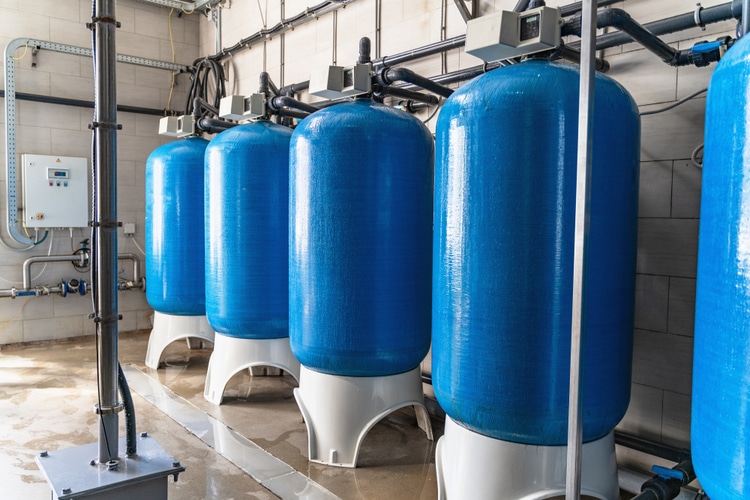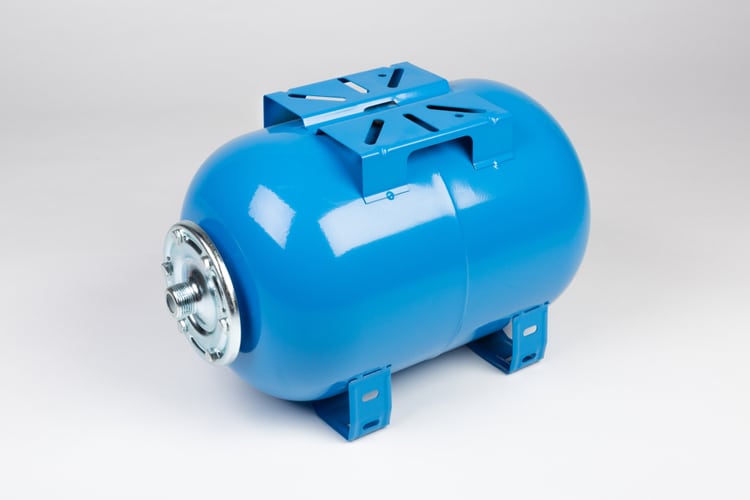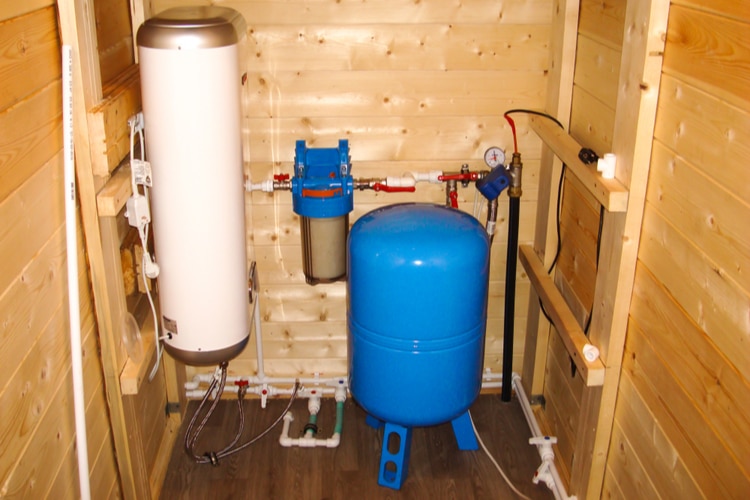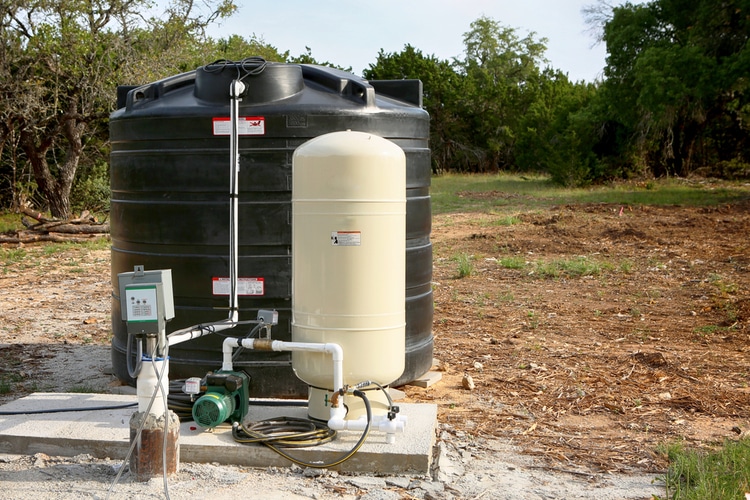How to Tell if Pressure Tank is Bad
There are a few clear signs that indicates if a pressure tank has stopped working properly. If you notice one or more of these signs, it might be a good time to get your pressure tank checked out:
- High fluctuation of water pressure from different water sources in your house
- Abnormal noises like clicking sounds coming from the water tank
- Spitting and spraying faucets or shower heads
- Extremely hot shower water
- Water tank turning on and off frequently (also known as short-cycling)
- The needle on your tank’s pressure gauge jumping frantically
- No water or low water pressure
- Flickering lights when water is being used
- Discolored water coming from your faucets
Certain tanks may also experience “waterlogging,” which is the term for when the entire tank is filled with water. Since pressure tanks should maintain a 1:3 water-to-air ratio to produce pressure, this prevents the tank from functioning properly. Depending on the cause, the solution to waterlogging might require replacing the whole tank.
It’s suggested that homeowners check their pressure tanks every so often to notice any visible signs of malfunctioning or deterioration. Check for leaks on the outside of the tank which can be detected by a trail of water running down the side. You can also look for wet spots or puddles of water underneath the base of the tank.
Another indicator that your tank needs replacement is if you see spots of rust or corrosion on the seams of the tank. While most signs that you need a pressure tank replacement can be easily observed, we recommend that you regularly inspect your unit to spot these signs early on.

How Long Do Pressure Tanks Last?
How long a pressure tank lasts depends on its type, and there are three types of tanks:
- Bladder tank: A high-quality bladder tank can last 10 to 15 years as long as it’s properly maintained.
- One-compartment tank: A one-compartment standard stainless steel system will only serve you for 5 to 7 years.
- Diaphragm tank: The life expectancy of a diaphragm is 5 to 15 years.
The difference between a higher-quality pressure tank and a cheaper one is the quality of the bladder inside the tank; or, in the case of standard one-compartment systems, the lack of a bladder.
The bladder is the compartment inside the tank that holds the water. When you use water in your home, the bladder fills up and empties itself, which is how your faucets create a stream.
Over time, due to the wear and tear of water passing through, bladders can become weak and break down. Cheaper tanks generally have less durable bladders than those of higher quality.
Standard stainless steel pressure tanks, on the other hand, have no bladder tank. Instead, the water and air are in constant contact inside the one-compartment tank to maintain pressure, and this contact is the main reason behind pressure tank problems like waterlogging that’s not a possibility for tanks with bladders.
Albeit less common than bladder or one-compartment tanks, there are also diaphragm tanks. These tanks employ a rubber diaphragm that separates air and water and creates pressure by expanding and absorbing.
However, unlike bladders, a rubber diaphragm can’t be replaced. So, when it suffers damage from sediment, debris, or mineral buildup, the whole system is rendered useless, and your only option is to replace it.
Malfunctioning Tank Components
In some cases, the tank itself may still be in working condition, but certain parts, like the bladder, may be malfunctioning. Homeowners should check the pressure of their tanks to detect any potential issues. This can be done in a few simple steps:
- Turn your pump breaker off and drain any remaining water left in the tank by turning on a faucet in your water system
- Take off the air valve cap
- If water is leaking from the valve, then your tank likely has a ruptured bladder, which will require a replacement
- Check the pressure by using your tank’s pressure gauge
Most well water pressure tanks that function with a pressure switch should be around 2psi below the pressure switch pump cut-in setting. You can adjust the pressure by adding or releasing air until your gauge matches the appropriate level.
When Should I Replace My Pressure Tank?
A well-maintained water tank can last more than 15 years before it needs a replacement. That said, water tanks usually come with a five-year warranty, and it’s possible to say that the warranty period is a reflection of how many years the manufacturer expects their device to last.
The lifespan of a pressure tank can also be affected by the quality of water it deals with. If the water is sandy, rocky, or has a lot of sediment, these contaminants can erode the pressure tank over time and even lead to the formation of a hole. If your well pumps coarse water, then you are likely to need a pressure tank replacement sooner than you might think.
There are steps you can take to prevent sediment-related problems:
- Installing a new filtration system that’s effective at removing contaminants
- Replacing your tank’s water filter on an annual basis to ensure that it’s not worn out
- Installing an air volume control system to prevent waterlogging issues
There are also good practices when it comes to the maintenance of your well, which can help you increase the longevity of your water tank. These include:
- Keeping fertilizers, pesticides, paints, oils, and all products that contain toxic chemicals away from your well pump so that they have no way of leaching into your water source
- Keeping the area around your well clean and being careful not to let leaves or debris pile up around it
- Being careful around the casing of your well
- Regularly checking the well cover or well cap on top of the casing of your well to make sure that there’s no risk of contamination or damage
Homeowners don’t need to have experience with well or pressure tank maintenance to follow these general maintenance guidelines, but if you’re unsure, it’s always best to contact a professional to inspect your unit. Poor care can harm your system, so it’s best to seek professional help if you’re not confident in your ability to identify and prevent issues.
How Much Does It Cost to Replace a Well Water Tank?
The price of a new pressure tank averages out to around $400, but depending on the size and quality requirements, you can expect to pay anywhere between $100 to $1500.
The typical cost of labor for installation can range from $125 to $200. The size and quality of the pressure tank can also affect the price of its installation.
That being said, the type of tank also has implications on how much the replacement will cost. There are three different types of well water tanks.
Diaphragm Well Pressure Tanks

Diaphragm pressure tanks generally cost between $200 and $500. Larger units can cost as much as $2500, however.
Bladder Well Pressure Tanks

Bladder well pressure tanks have the bladder held by screws, which makes its replacement straightforward. The downside is that when air escapes, there’s a loss of efficiency.
Due to this slight disadvantage, bladder well tanks can be as cheap as $150, with more expensive units being closer to $400. Better quality and higher volume bladder tanks can go as high as $1500.
One-Compartment Well Pressure Tanks

With one-compartment well pressure tanks, there is no separation between the water and the air, hence the name “one-compartment tank.” These units eliminate the risk of failure within the pressure tank itself but come with an increased chance of waterlogging. The typical price range for one-compartment pressure tanks is between $100-$300.
Conclusion
A bad pressure tank often reveals itself with inconsistent water pressure, abnormal noises, a short-cycling well pump, and frantic pressure gauge readings. If you’re experiencing any of these problems, it’s best to contact a professional plumber to ascertain the root of the issue.
If the plumber’s inspection reveals that the cause is indeed the pressure tank, it’s likely that you’ll need to replace it unless it’s waterlogged and the plumber has another course of action in mind.
Depending on the size, type, and quality you choose, you may expect to pay anywhere between $100 and $1500 for a replacement tank.